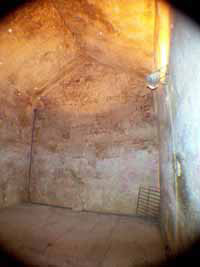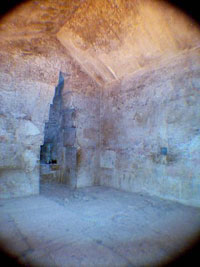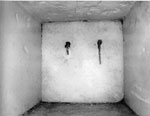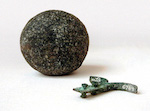The so called Queen’s Chamber of the Great Pyramid of Giza received its name from Arab explorers, but scholars now agree that it was not actually intended to be the burial chamber of a queen. You enter through a horizontal passageway from the lower end of the Great Gallery.
About five meters from the end of the passage, there is a step, before the passage slopes downward a further sixty centimetres to the floor level of the Queen’s Chamber. There is some speculation regarding this step. Some argue that the pink granite floor blocks originally started at the edge of the step and ran to join the floor of the chamber (so in fact there was no step). They suggest these blocks (being easier to remove) were stolen in antiquity. Others suggest that this feature is the result of the “changes in building plans” often referred to in discussions regarding this monument.


The chamber is made entirely of beautifully finished limestone blocks with a gabled ceiling. It sits on the twenty-fifth course of masonry on the pyramid’s east-west axis. The walls are bare with no inscription, but there is a niche in the east wall about four and a half meters up from the floor. The niche also has a corbel ceiling. It is possible that a statue of the king or his ka (soul) might have stood in the niche, but this is pure speculation. Lehner argues that the Queen’s Chamber would have been sealed off, transforming it into a Serdab (a room for the king’s spiritual soul or Ka as found in many pyramids and in Djoser’s Step Pyramid Complex).
The Queen’s Chamber Shafts
The two “air shafts” in the Queen’s Chamber were originally bricked up and not discovered until 1872. Averaging about twenty centimetres square, they rise from the north and south walls of the chamber and climb steeply up through the masonry above. The shafts are not entirely straight. The north shaft bends after about seventeen meters, possibly to curve around the grand galley. Similar shafts can also be found in the King’s Chamber.
In 1993, Gantenbrink sent a robot called Upuaut2 (Wepwawet – “the opener of the ways”) to video the inner walls of the shafts. He discovered that the southern shaft ended with a small Tura limestone slab in which two heavily corroded pieces of copper had been inserted. The door is estimated to be about six centimetres thick and is only about six meters from the outer surface of the pyramid. He tried to video the northern shaft, but couldn’t get around the curve.
In 2002, a National Geographic robot, inserted a miniature fiber-optic camera into a three-quarter-of-an-inch hole to reveal a rough-hewn blocking stone about 21 centimetres beyond the original southern shaft door. It looks as if it is covering something, and there are cracks all over its surface. Shortly after, a robot built by iRobot of Boston made it up the north shaft, only to discover a door just like that of the southern shaft. The doors are equidistant to the Queen’s Chamber.



Work continued in 2011 with the “Djedi Project” which used a fiber-optic “micro snake camera” to see around the corners. They made it past the first door of the southern shaft to get a look at the small chamber behind it. They found hieroglyphs written in red paint which may be worker’s marks or graffiti – no meaning has been suggested for them. They confirmed that the inside of the door was polished, suggesting it had a ritual or symbolic purpose rather than being intended only to block the shaft. They also had a closer look at the two copper “handles” embedded in the door, and suggested they were only decorative.
Three strange objects were found in the Queen’s chamber; a granite sphere, a wooden slat, and a copper object in the form of a swallow’s tail (referred to as a hook). They were originally discovered by Dixon in 1872, but lost until the ball and hook were rediscovered in the British Museum depository.
Bibliography
- Bard, Kathryn (2008) An introduction to the Archaeology of Ancient Egypt
- Kemp, Barry J (1991) Ancient Egypt: Anatomy of a Civilisation
- Lehner, Mark (1997) The Complete Pyramids
- Malek, J (2000) “The Old Kingdom”, in The Oxford History of Ancient Egypt Ed I. Shaw
- New Scientist (25 May 2011) “First images from Great Pyramid’s chamber of secrets”
- Verner, Miroslav (1997)The Pyramids
Copyright J Hill 2016